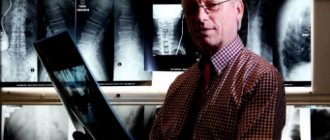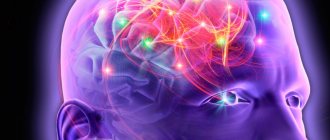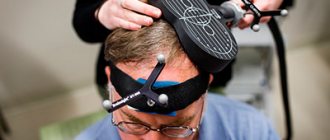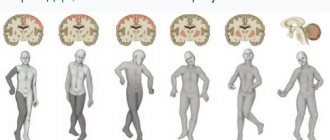Symptoms
Spinal shock is one of the most serious diseases, which is characterized by disorders of the motor, sensory and reflex functions of the spinal cord. Moreover, this happens only at a level below the affected area. This condition develops quite quickly, and sometimes it takes only a few hours, in more rare cases - several days, and very rarely - weeks.
The main clinical manifestations of this condition from the autonomic nervous system should be considered a decrease in heart rate, low blood pressure and a decrease in body temperature. Another important clinical sign that may later become the cause of anterior spinal syndrome is a disruption of the gastrointestinal tract.
During the shock itself, it is impossible to assess how badly the nervous system has been damaged and what can be expected as consequences. Moreover, it is quite difficult to say why exactly this pathology occurs. Many authors who studied it in some detail noted their reasons for its development.
The deepest and most prolonged shock of this kind occurs in the case of an anatomical rupture of the spinal column. In this case, there is complete paralysis of the body below the place where the brain breaks and a complete disruption of all types of sensitivity and functions. But the uncomplicated form can last from 15 to 20 days. But clinical studies have shown that this time can be greatly extended, and most patients recover from this condition no earlier than 4 to 8 weeks after the injury. Moreover, the symptoms can not only pass, but also increase, for example, in the presence of a hematoma or fragments of vertebral bones that will compress the brain.
Causes of spinal stroke
The causes of spinal stroke are usually divided into two main groups: primary and secondary. Primary ones directly depend on the condition of the vessel responsible for feeding a particular segment of the spinal cord: thrombosis, embolism, developmental anomalies, aneurysms, vasculitis, infectious and inflammatory lesions, etc. Secondary ones are caused by the presence of concomitant diseases that affect the functioning of the cardiovascular system: atherosclerosis, hypertension, osteochondrosis, structural anomalies of the vertebrae, blood diseases, hormonal disorders, oncology, etc. Spinal injuries due to aggressive external influences or surgical intervention should be considered separately.
All these reasons lead to disruption of the blood supply to the spinal cord and its individual structures. Metabolic processes occurring in nerve cells are active, so a lack of oxygen and nutrients leads to their irreversible damage and death.
Classification
According to the degree of damage to the spinal column, all types of injuries can be divided into several categories:
- Complete damage, in which there is no motor or sensory function.
- Incomplete - in this case, motor function is preserved above the fracture site and is completely absent below it.
- Incomplete - motor functions remain below the affected area, and muscle strength reaches only 3 points.
- Incomplete when motor function is preserved below the injury site and muscle strength is more than 3 points.
- No damage. Here all functions are fully preserved.
Treatment of spinal stroke
Treatment of a spinal stroke involves a set of measures that depend on the type of injury, the symptoms caused, the patient’s age and his individual characteristics. Treatment of patients at the Yusupov Hospital is carried out in stages; for ischemic types of lesions, therapy is aimed at normalizing the rheological properties of the blood, dissolving blood clots, eliminating vasospasm and swelling of brain tissue. After the acute period, rehabilitation measures are prescribed that help eliminate the consequences and restore lost functions. According to indications, surgical intervention is performed after consultation with a neurosurgeon. Therapy for hemorrhagic stroke of the spinal cord at the Yusupov Hospital is aimed at relieving swelling, stopping bleeding, restoring blood supply and returning lost functions.
Neurologists at the Yusupov Hospital create comprehensive individual treatment and rehabilitation programs for each individual patient, which allows them to reduce the degree of disorders caused, prevent serious consequences, improve the quality of life, and return a person to a full life. You can make an appointment with a doctor and find out detailed information about treatment and rehabilitation by phone.
Diagnostics
It is very important to carry out a timely diagnosis and learn to distinguish shock from another, no less common condition after injury, which is called autonomic dysreflexia. In this case, the symptoms of the disease will be as follows:
- High blood pressure.
- Rare pulse.
- Headache that is throbbing in nature.
- Anxiety.
- Sweating skin.
- Stomach ache.
Dysreflexia is treated over 2–4 days, and this is done symptomatically.
Types of spinal stroke and their signs
Circulatory disorders of the spinal cord can occur in hemorrhagic, ischemic and mixed types. Ischemic stroke is more often recorded in people over 50 years of age; it is formed as a result of compression or blockage of a vessel. Symptoms of ischemia increase gradually, long-term consequences become apparent within a week to several months. Focal symptoms depend on the location of the damage and its volume. The most commonly diagnosed symptoms are:
- Weakness in the limbs that goes away on its own;
- Loss of sensitivity in the limbs;
- Pain in the muscle area;
- Urinary disorders;
- Pain in the spine.
There are certain syndromes that can be used to suggest the location of the damaged area. Ischemia of the spinal and vertebral arteries is manifested by bilateral paralysis of the limbs, sensory disturbances, sphincter paresis, and respiratory distress. Damage to the posterior spinal artery is accompanied by disturbances of superficial sensitivity, tremors of the hands, and paresis of the legs. Damage to the vertebral and radicular arteries causes paresthesia, disruption of muscles and joints, and convulsive muscle twitching. Ischemia of the radicular arteries leads to the appearance of girdle pain, changes in temperature sensitivity, increased knee reflexes, decreased abdominal reflexes and other signs.
A hemorrhagic stroke of the spinal cord is formed due to the rupture of a vessel and further hemorrhage under the membranes (hematorachis) or into the brain tissue. When hemorrhaging into the substance of the spinal cord, the patient experiences girdle pain, paralysis of the limbs of varying degrees, sensitivity disorders, and dysfunction of the pelvic organs. Hemorrhage under the membranes is recorded extremely rarely; it is accompanied by sharp pain and symptoms of brain damage, which lasts several days.
If unfavorable symptoms appear, you should immediately consult a doctor, since the outcome and consequences of the disease depend on the speed and quality of care. You can undergo a full examination, comprehensive treatment and rehabilitation at the neurology clinic of the Yusupov Hospital.
Complications
After the main phenomena regress, a period of residual phenomena begins. And here a complication such as damage to the ventral half of the spinal cord comes to the fore. Moreover, this happens only in the case of incomplete damage. This also includes posterior spinal syndrome, centromedullary syndrome, cauda equina syndrome and Brown-Séquard syndrome.
Anterior spinal syndrome is the result of a hyperflexion injury. This happens most often in traffic accidents or when diving head first. This is what is accompanied by spinal cord disorders. Basically, this type of injury occurs in the neck area, and to be more precise, from the 3rd to 7th cervical vertebrae. In addition to a compression fracture, vertebral dislocation may also occur. As a manifestation of spinal injury, it is relatively rare and the main cause should still be considered car accidents.
Manifestations of spinal stroke
A spinal stroke is characterized by sudden back pain accompanied by spinal cord symptoms within an hour. Depending on the location of the blockage of the vessel, symptoms of damage develop, such as segmental or transverse lesions of the spinal cord. The lower thoracic region of the spinal cord is most susceptible to ischemic stroke.
Depending on the location of the ischemic focus in patients suffering from a spinal cord stroke, neurologists identify the following symptoms:
- paralysis of two or four limbs;
- pain (in 80% of cases);
- sensitivity disorders;
- pelvic disorders.
Spinal stroke manifests itself in several syndromes:
- Preobrazhensky syndrome is characterized by loss of pain and temperature sensitivity, disruption of the pelvic organs, and paralysis of the limbs. When the focus of ischemia is localized in the cervical spine, flaccid complete or partial paralysis of the arms and spastic paralysis or paresis of the legs are determined. A stroke in the thoracic spine is characterized by spastic paresis of the lower extremities, and a stroke in the lumbar region is characterized by flaccid incomplete paralysis of the legs. With a stroke of the sacrolumbar region, reflexes disappear, feces and urine are retained;
- Ischemic anterior poliomyelopathy syndrome is observed with partial damage to the anterior part of the spinal cord. Paresis of the arms or legs develops, with partial atrophy or disappearance of muscle reflexes;
- centromidular ischemia syndrome is manifested by cerebellar ataxia (impaired coordination of movements not associated with muscle weakness), paresis of the limbs, conductive weakening of sensitivity in the two limbs of the same name;
- Amyotrophic lateral sclerosis syndrome develops in the presence of a focus of ischemia in the upper part of the spinal cord. It manifests itself as weakness in the upper arms and legs, atrophy of some muscles of the hands, increased reflexes;
- ischemia syndrome across the spinal cord appears due to blockage of the radiculomedullary artery. It extends to the thoracic, cervical and dorsal spine, depending on the extent of the lesion.
Consequences
The consequences of a spinal stroke can be very different. If the lesion is small in size and timely drug therapy or surgical treatment is possible, a 100% recovery is possible, but the patient must undergo clinical observation and preventive treatment courses. A less favorable outcome is also possible when, despite treatment, the patient remains with motor, sensory and pelvic disorders. Such disorders can lead to disability:
- paresis of the limbs (one or more) – weakness in the muscles persists, which makes independent movement and self-care difficult;
- areas of hypoesthesia or anesthesia - on the trunk or limbs there is reduced or absent sensitivity. This can be pain, temperature, tactile sensitivity, as well as more complex types of sensitivity, such as a sense of localization, stereognosis (recognition of objects by touch with eyes closed), two-dimensional spatial sense (the ability to recognize letters and numbers drawn on the body with eyes closed). ) etc. For some patients, this may cause loss of ability to work - a seamstress or musician cannot perform professional skills if there is no sensitivity in the hands;
- disorders of urination and defecation - this problem is especially painful for patients, as it affects the intimate sphere of a person. Variations in the degree and nature of the disorder are possible: urinary incontinence, constant dribbling of urine, periodic uncontrolled urination, the need to strain to urinate, fecal incontinence.
General information about the blood supply to the spinal cord
The blood supply to the spinal cord comes from two pools: the vertebral-subclavian and the aortic. The spinal subclavian basin supplies the spinal cord in the upper sections: cervical and thoracic segments to Th3 (third thoracic segment). The aortic blood supply supplies the thoracic segments from Th4 and below, the lumbar, sacrococcygeal segments. From the vertebral artery, the subclavian artery and the aorta, the radicular arteries arise, which form the anterior spinal artery and two posterior spinal arteries that run along the entire spinal cord.
The blood supply to the spinal cord is very variable, the number of radicular-spinal arteries ranges from 5 to 16. The largest anterior radicular-spinal artery (up to 2 mm in diameter) is called the artery of the lumbar enlargement, or the artery of Adamkiewicz. Turning it off leads to the development of a characteristic clinical picture with severe symptoms. In a third of cases, one Adamkiewicz artery supplies the entire lower part of the spinal cord, starting from the 8-10th thoracic segment. In some cases, in addition to the artery of the lumbar enlargement, the following are found: a small artery entering with one of the lower thoracic roots, and an artery entering with the V lumbar or I sacral root, supplying the conus and epiconus of the spinal cord - the Deproge-Gotteron artery.
The anterior spinal artery system vascularizes 4/5 of the diameter of the spinal cord: the anterior and lateral horns, the bases of the dorsal horns, Clarke's columns, the lateral and anterior columns and the ventral sections of the dorsal columns. The posterior spinal arteries supply the posterior columns and the apex of the dorsal horns. There are anastomoses (natural connections of organs) between the systems.
Knowledge of the angioarchitecture (structure) of the spinal cord is necessary to understand the mechanisms of circulatory disorders and clinical diagnosis.











